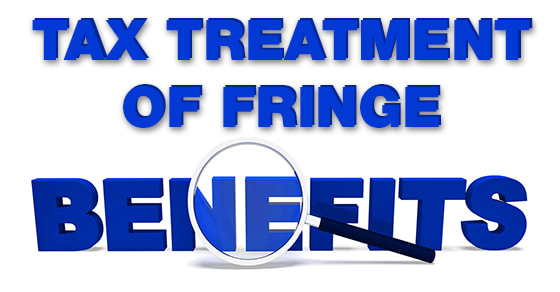|
Now that we’ve hit midsummer, if you own a vacation home that you both rent out and use personally, it’s a good time to review the potential tax consequences:
If you rent it out for less than 15 days: You don’t have to report the income. But expenses associated with the rental (such as advertising and cleaning) won’t be deductible. If you rent it out for 15 days or more: You must report the income. But what expenses you can deduct depends on how the home is classified for tax purposes, based on the amount of personal vs. rental use:
Look at the use of your vacation home year-to-date to project how it will be classified for tax purposes. Adjusting the number of days you rent it out and/or use it personally between now and year end might allow the home to be classified in a more beneficial way. For assistance, please contact us. We’d be pleased to help. © 2017
0 Comments
According to IRS Publication 5137, Fringe Benefit Guide, a fringe benefit is “a form of pay (including property, services, cash or cash equivalent), in addition to stated pay, for the performance of services.” But the tax treatment of a fringe benefit can vary dramatically based on the type of benefit.
Generally, the IRS takes one of four tax approaches to fringe benefits: 1. Taxable/includable. The value of benefits in this category are taxable because they must be included in employees’ gross income as wages and reported on Form W-2. They’re usually also subject to federal income tax withholding, Social Security tax (unless the employee has already reached the current year Social Security wage base limit) and Medicare tax. Typical examples include cash bonuses and the personal use of a company vehicle. 2. Nontaxable/excludable. Benefits in this category are considered nontaxable because you may exclude them from employees’ wages under a specific section of the Internal Revenue Code. Examples include:
3. Partially taxable. In some cases, the value of a fringe benefit will be excluded under an IRC section up to a certain dollar limit with the remainder taxable. A public transportation subsidy under Section 132 is one example. 4. Tax-deferred. This designation applies to fringe benefits that aren’t taxable when received but that will be subject to tax later. A common example is employer contributions to a defined contribution plan, such as a 401(k) plan. Are you applying the proper tax treatment to each fringe benefit you provide? If not, you could face unexpected tax liabilities or other undesirable consequences. Please contact us with any questions you have about the proper tax treatment of a particular benefit you currently offer or are considering offering. © 2017 It’s common for a business to own not only typical business assets, such as equipment, inventory and furnishings, but also the building where the business operates — and possibly other real estate as well. There can, however, be negative consequences when a business’s real estate is included in its general corporate assets. By holding real estate in a separate entity, owners can save tax and enjoy other benefits, too.
Capturing tax savings Many businesses operate as C corporations so they can buy and hold real estate just as they do equipment, inventory and other assets. The expenses of owning the property are treated as ordinary expenses on the company’s income statement. However, if the real estate is sold, any profit is subject to double taxation: first at the corporate level and then at the owner’s individual level when a distribution is made. As a result, putting real estate in a C corporation can be a costly mistake. If the real estate is held instead by the business owner(s) or in a pass-through entity, such as a limited liability company (LLC) or limited partnership, and then leased to the corporation, the profit on a sale of the property is taxed only once — at the individual level. LLC: The entity of choice The most straightforward and seemingly least expensive way for an owner to maximize the tax benefits is to buy the real estate outright. However, this could transfer liabilities related to the property (such as for injuries suffered on the property) directly to the owner, putting other assets — including the business — at risk. In essence, it would negate part of the rationale for organizing the business as a corporation in the first place. So, it’s generally best to put real estate in its own limited liability entity. The LLC is most often the vehicle of choice for this. Limited partnerships can accomplish the same ends if there are multiple owners, but the disadvantage is that you’ll incur more expense by having to set up two entities: the partnership itself and typically a corporation to serve as the general partner. We can help you create a plan of ownership for real estate that best suits your situation. © 2017 You may be tempted to forget all about taxes during summertime, when “the livin’ is easy,” as the Gershwin song goes. But if you start your tax planning now, you may avoid an unpleasant tax surprise when you file next year. Summer is also a good time to set up a storage system for your tax records. Here are some tips:
Take action when life changes occur. Some life events (such as marriage, divorce, or the birth of a child) can change the amount of tax you owe. When they happen, you may need to change the amount of tax withheld from your pay. To do that, file a new Form W-4 with your employer. If you make estimated payments, those may need to be changed as well. Keep records accessible but safe. Put your 2016 tax return and supporting records together in a place where you can easily find them if you need them, such as if you’re ever audited by the IRS. You also may need a copy of your tax return if you apply for a home loan or financial aid. Although accessibility is important, so is safety. A good storage medium for hard copies of important personal documents like tax returns is a fire-, water- and impact-resistant security cabinet or safe. You may want to maintain a duplicate set of records in another location, such as a bank safety deposit box. You can also store copies of records electronically. Simply scan your documents and save them to an external storage device (which you can keep in your home safe or bank safety deposit box). If opting for a cloud-based backup system, choose your provider carefully to ensure its security measures are as stringent as possible. Stay organized. Make tax time easier by putting records you’ll need when you file in the same place during the year. That way you won’t have to search for misplaced records next February or March. Some examples include substantiation of charitable donations, receipts from work-related travel not reimbursed by your employer, and documentation of medical expenses not reimbursable by insurance or paid through a tax-advantaged account. For more information on summertime tax planning or organizing your tax-related information, contact us. © 2017 Summer is a popular time to move, whether it’s so the kids don’t have to change schools mid-school-year, to avoid having to move in bad weather or simply because it can be an easier time to sell a home. Unfortunately, moving can be expensive. The good news is that you might be eligible for a federal tax deduction for your moving costs.
Pass the tests The first requirement is that the move be work-related. You don’t have to be an employee; the self-employed can also be eligible for the moving expense deduction. The second is a distance test. The new main job location must be at least 50 miles farther from your former home than your former main job location was from that home. So a work-related move from city to suburb or from town to neighboring town probably won’t qualify, even if not moving would increase your commute significantly. Finally, there’s a time test. You must work full time at the new job location for at least 39 weeks during the first year. If you’re self-employed, you must meet that test plus work full time for at least 78 weeks during the first 24 months at the new job location. (Certain limited exceptions apply.) What’s deductible So which expenses can be written off? Generally, you can deduct transportation and lodging expenses for yourself and household members while moving. In addition, you can likely deduct the cost of packing and transporting your household goods and other personal property. And you may be able to deduct the expense of storing and insuring these items while in transit. Costs related to connecting or disconnecting utilities are usually deductible, too. But don’t expect to write off everything. Meal costs during move-related travel aren’t deductible. Nor is any part of the purchase price of a new home or expenses incurred selling your old one. And, if your employer later reimburses you for any of the moving costs you’ve deducted, you may have to include the reimbursement as income on your tax return. Questions about whether your moving expenses are deductible? Or what you can deduct? Contact us. © 2017 |
AuthorAdam Carr, MBA, EA Archives
June 2024
Categories
All
|






 RSS Feed
RSS Feed

